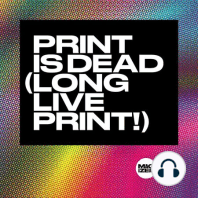66 min listen

Metropolitan Home: Dorothy Kalins (Editor) and Don Morris (Designer)
Metropolitan Home: Dorothy Kalins (Editor) and Don Morris (Designer)
ratings:
Length:
52 minutes
Released:
Mar 3, 2023
Format:
Podcast episode
Description
For me, the 1980s comes down to two things: The Nakamichi RX-505 Cassette Deck and Metropolitan Home magazine. _____ First, the gear. _____ The Nakamichi RX-505 was an audiophile’s wet dream. It was prominently featured in the steamy 1986 film, 9½ Weeks. In a scene from that movie, Mickey Rourke walks Kim Basinger into his monochrome Hell’s Kitchen penthouse, where she glides through a living room full of furniture by Marcel Breuer, Richard Meier, and Charles Rennie Mackintosh. In the middle of it all, the Nakamichi opens, flips the Brian Eno cassette, and closes, automatically. _____ And now, the magazine. _____ Eighties movies featured a slew of inspirational apartments: Tom Hanks’ Soho loft in Big, Judd Nelson and Ally Sheedy’s Georgetown pad in St. Elmo’s Fire, Billy Crystal’s East Village flat in When Harry Met Sally. So when apartment dwellers from Des Moines to Manhattan asked themselves “How can I make my apartment look like the ones in the movies,” they turned to Met Home. _____ While the old guard, House & Garden, Architectural Digest, and House Beautiful, relished in displaying palatial estates and lavish celebrity spreads, Met Home was the design inspiration for the rest of us. _____ By the mid-80s — thanks to today’s guests: editor Dorothy Kalins and designer Don Morris — Met Home was the best-selling shelter magazine in America, boasting a higher circulation than all of them. _____ It was a magazine rich with design and lifestyle inspiration and beautiful apartments and houses, but Met Home was not a typical decorating magazine. Its stories were very personal and captured its subjects’ individual passion for the things that surrounded them. _____ But it didn’t last long. By the early 90s, thanks to a recession, Meredith sold Met Home to Hachette, who out-bid Jann Wenner’s Straight Arrow Publishers for the magazine. Hachette, though, was more focused on its own shelter book, Elle Decor, and left Met Home to languish and fade. _____ Kalins and Morris were gone, each off on their own new adventures. _____ For many of us, Metropolitan Home was a special magazine from a special time. A hopeful time. We were moving out — to dorms, first apartments, or starter homes. We bought affordable modern furniture from a brand-new Swedish big-box store called Ikea. We drank the New Coke while we played Donkey Kong on our Nintendos. We sang along with “We Are the World.” We watched Top Gun — the original — on our VCRs. And we paid an average of $375 (!!) a month for our rent. _____ Met Home gave its intrepid readers permission to indulge themselves in creating their own home design. And, as Morris says, “We helped expose people to a lot of design trends, but also gave them a sense of how they might be able to bring that into their own lives.”
Released:
Mar 3, 2023
Format:
Podcast episode
Titles in the series (46)
Roger Black (Designer: Rolling Stone, Newsweek, New York, more): Roger Black is a pioneer. His art direction of iconic print brands and high-profile redesigns, his early embrace of digital publishing technology, and his typographic innovations are hallmarks of a 50-year, trailblazing career. He’s refined his design mastery at publications ranging from Rolling Stone to Esquire to Newsweek to The New York Times Magazine. He’s written books and started companies. He’s worked for clients on every continent. And now, at 73, Black’s focus has shifted to type. More specifically Type Network, a font platform launched in 2016, where he serves as the company’s chairman. Black’s design legacy not only includes memorable makeovers but also the fundamental need for an underlying reason and purpose behind them, often sophisticated, always functional. Throw in his signature color palette — red, white, and of course, Black — and you’re in business. All that said, Black preaches that the true DNA by Print Is Dead (Long Live Print!)